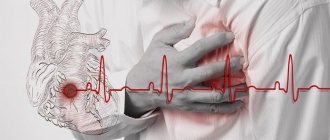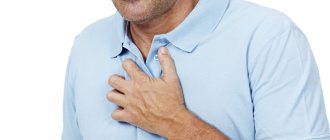The autonomic nervous system is responsible for the normal functioning of internal organs: heart, blood vessels, gastrointestinal tract, respiratory system. Therefore, when its functioning is disrupted, a wide variety of manifestations can occur, including panic attacks, a feeling of lack of air, and pain in the heart. Breathing exercises for vegetative-vascular dystonia (VSD) will help normalize disturbed processes and improve well-being.
Why is breathing exercise useful for VSD?
Autonomic vascular dystonia is a functional disorder in which the structure of the organ does not suffer, but only the regulation of its work is disrupted. This condition is provoked by stress, mental stress, increased physical or emotional stress.
Translated from Latin, “vegeto” means excitement. During attacks of VSD, “vascular excitation” occurs: blood pressure rises and falls, a feeling of lack of air appears, the heartbeat quickens, and dizziness occurs. Various fears (panic attacks) are also characteristic, ranging from the fear of death to the fear of speaking (also known as glossophobia).
It is during such attacks that breathing exercises are of great importance. It allows you to find the correct breathing rhythm so that the blood is saturated with oxygen, the feeling of shortness of breath disappears, and the heart begins to beat more slowly. Also, respiratory exercises help to distract from worries and fears - and the attack gradually passes.
Reviews
Tatyana, 35 years old: “I have been suffering from VSD for many years. In recent years, panic attacks due to private stress have become more frequent. The doctor advised vegetotropic breathing. I chose Tibetan gymnastics for myself. Now I don’t do the exercises every day, but the effect of gymnastics has remained.”
Anton, 42 years old: “In recent years, blood pressure has increased more often, and VSD has worsened. I practiced independently using Strelnikova’s complex of gymnastics and breathing exercises and managed to achieve slight improvements. The pressure has stabilized and does not fluctuate so sharply. I began to feel more cheerful, the symptoms of VSD became less.”
Oksana, 19 years old: “I’ve had VSD since I was 8 years old, every session at the institute began to be accompanied by anxiety. I had seizures several times, it was hard to breathe, I almost fainted. I discovered breathing exercises. I don’t have time to study all the time, and I’m lazy. But as an emergency measure to calm down, in most cases these exercises help.”
Why do you need breathing exercises?
Performing a set of breathing exercises for VSD is necessary to solve several problems:
- Stabilization of heart function;
- Restoring the rhythm of breathing;
- Suppressing anxiety and fear;
- Normalization of blood pressure;
- Blood oxygen saturation;
- Stopping dizziness;
- Increasing the tone and endurance of the body.
Classes do not have to be carried out only during a panic attack. During the interictal period, they have a preventive value and make the nervous system more resistant to stress.
Breathing exercises
In everyday life, we rarely pay attention to how we breathe. But proper breathing is a whole science that requires special study and long-term training. In order for breathing movements to become as effective as possible, it is necessary to master the techniques of diaphragmatic, abdominal, thoracic, deep and shallow breathing.
Breathing and vegetative-vascular dystonia
The appearance of shortness of breath during an attack of VSD is not a sign of a disease of the respiratory system, but only an inadequate reaction of the nervous system to a mental stimulus. Nevertheless, for the patient this condition is extremely unpleasant: he develops a feeling of inadequacy of inhalation and a fear of death.
Note!
If the attack is truly caused by VSD, and all examinations of the heart and lungs do not reveal pathology, then a person has no real risk of dying during a panic attack. Loss of consciousness may occur due to fluctuations in blood pressure or vasospasm. But the mechanisms of breathing regulation work automatically in the body, so it is impossible to suffocate in such a situation.
The most important thing that a patient with VSD must learn is to calm down on his own. And measured breathing helps him with this. It distracts from groundless worries and fears, saturates the blood with a large amount of oxygen, sufficient for the feeling of lack of air to pass.
Basics of proper breathing
Before you start practicing, you need to learn the basic principles of proper breathing:
- You should start breathing exercises with a small number of repetitions (about three), gradually increasing them (up to 8-10).
- It is advisable to exercise three times a day before meals.
- If the exercise involves physical activity, then you need to move smoothly, without jerking movements.
- Full concentration on your own feelings is important. Make sure you are not distracted by external stimuli.
Important!
If during class you feel dizzy, light-headed, or have darkness in your eyes, then the workout should be suspended until you feel normal, and then slow down a little.
Tips for proper breathing
- Breathing movements should be measured and rhythmic.
- Most gymnastic elements involve inhaling through the nose - this way the air is better purified and warmed. Exhalation can be done both through the nose and through the mouth.
- When breathing, try to use not only your chest, but also your stomach. First, air fills the upper and middle parts of the lungs, expanding the ribs, and then enters the lower sections, the diaphragm lowers, and the abdominal wall protrudes.
- All bending, relaxing, squatting, lowering the arms are accompanied by exhalation, straightening, raising the limbs - by inhaling.
Basic exercises
We list the basic exercises that you need to master first:
- We breathe rhythmically, at a comfortable pace. Then we inhale alternately with the right and then with the left half of the nose, blocking the second. We exhale through our mouth.
- As you inhale, inflate your stomach, and as you exhale, draw it in. For convenience, you can put one palm on your chest, the other on your abs, and thus control their movements.
- Now we breathe only through the chest, without using the stomach in any way.
What is characteristic of vegetative-vascular dystonia
It is important for a VSD patient to understand that his arrhythmia is of a functional nature. And no matter where exactly and in what quantity it occurs, one thing is clear: the heart is healthy, and the reason lies in something completely different.
Extrasystole in such patients manifests itself when a large amount of adrenaline enters the blood. But as soon as it decreases to normal, all sensations subside. That is, the problem is temporary and reversible. But patients tolerate it very hard. For them, this is like death: heart failures catch them suddenly, they can be repeated for several months and even years, until the cause is eliminated.
At this moment, a person is seized by a feeling of fear. He begins to choke, his legs give way, and he may lose consciousness. The patient becomes pale, begins to rush about, and scream. The sensation in the chest resembles a blow to the rib cage.
An even greater fear is the compensatory break after an extraordinary compression. The patient fears that his heart will stop. It seems to him that he will die, and this cannot be avoided.
If the excitement intensifies, then the symptoms worsen. Atrial fibrillation occurs. It seems that the heart works outside the regime, chaotically, as it pleases. Fortunately, this condition rarely occurs.
Breathing exercises
The breathing exercises proposed by different authors are quite heterogeneous. We have selected the most effective ones. Some are designed to relieve panic attacks, while others are suitable for daily use.
Exercise by Dr. Kurpatov
Dr. Kurpatov points out that the feeling of fear is formed during the pause between inhalation and exhalation. Accordingly, first of all, this pause needs to be shortened. He proposed his own exercise to regulate breathing during a panic attack with vegetative-vascular dystonia.
First, we sequentially inhale air, hold our breath and exhale. Each stage should last 5 seconds. The inhalation retains this duration, but the pause gradually shortens, “giving” its seconds to the exhalation. That is, in the next respiratory cycle, inhalation lasts 5 seconds, pause – 4 seconds, exhalation – 6 seconds, then: inhalation – 5 seconds, pause – 3 seconds, exhalation – 7 seconds. etc. As a result, there is no pause at all between inhalation and exhalation, and exhalation is extended to 10 seconds.
Sound exercise
A slow, deep breath is taken for seven seconds, then the air is released through the mouth with a drawn-out sound “eeee”, “aaa”, “oooh”. You can also draw out the consonant sounds “shshsh”, “xxx”, “mmm”. They are more effective for training the lungs.
If you do the exercise during an attack, you may not be able to speak clearly. If instead of clear sounds you get sobs and sobs, do not try to suppress them. They help relax the diaphragm and relieve muscle block.
Static classes
These are exercises that only involve breathing in a certain rhythm. The body and limbs are in an arbitrary relaxed state: lying down, sitting on the floor or on a chair.
Exercise "Steps"
First, completely exhale the air from your lungs. Then inhale it in small portions, pausing for two seconds after each short inhalation. Now also exhale gradually. As you exhale, you can make a short “hmm” sound. This exercise is perfect during the interictal period to activate the body if you are worried about lethargy, general weakness, and apathy.
Exercise "Flower"
Imagine that you want to smell a fragrant flower and inhale deeply through your nose. Exhale freely. You can gradually speed up the pace, but do not overdo it: with frequent deep breathing there is a risk of developing hyperventilation and dizziness.
Classes with elements of dynamics
The following exercises involve physical activity and a certain body position while performing breathing exercises.
Exercise "Blacksmith's bellows"
At a fast pace, perform 30 sharp exhalations through the nose, while sharply drawing in the abdominal muscles. At the same time, the hands perform “blows” with their fists in the air. You can jump in time with your breathing movements.
Exercise "Pacification"
Suitable for suppressing aggression. Raise your straight arms up as you inhale, and as you exhale, sharply bend them at the elbows, hitting yourself on the front surface of the chest.
From yoga gymnastics
In Eastern practices, breathing techniques are designated by the term “Pranayana”, which implies inhaling prana - vital energy - along with air. To perform it correctly, you need to sit in the lotus position. If this is a difficult task for you, you can simply cross your legs “Turkish style”.
Keeping your back and head straight, we inhale slowly, feeling how the air consistently fills the tops of the lungs, the entire chest and lower sections, pushing back the diaphragm. At the height of inhalation, pause for a couple of seconds, and then slowly exhale. Allow 5-10 minutes for this task.
Exercise "Crane"
It also comes to us from yoga. Lie on your back with your legs straight up. As you exhale, bring them closer to your head, and as you inhale, bring them back. The inhalation should be 2 times shorter than the exhalation.
Playing sports
Often people do not differentiate between the concepts of “sport” and “physical therapy”. However, the difference between them is significant. Exercise therapy involves light health-improving physical activity that even a sick person can handle. They are primarily necessary for the body’s adaptation to external conditions.
Professional sport is aimed at achieving certain results in competitions. Intense muscle work occurs, the cardiovascular and respiratory systems are also subject to significant stress. Therefore, you can fearlessly engage in sports only against the backdrop of good health.
Is it possible to play sports with VSD?
In fact, vegetative-vascular dystonia is not a direct contraindication to sports activities. In part, they will even be beneficial: the resistance of all body systems to stress will increase, blood vessels will begin to react less acutely to changes in external conditions, and a person will feel better. However, playing sports against the background of VSD can also have negative consequences:
- Excessive loads can cause adaptation failure;
- When engaging in traumatic sports against the background of a suddenly developed attack of VSD, there is a risk of harming one’s own health;
- When participating in competitions, excitement and anxiety appear, which can aggravate the symptoms of VSD;
- In team sports, responsibility for the entire team appears, and increased nervous tension can also lead to an exacerbation of the disease.
Therefore, in each case, this issue is resolved individually and only after consulting a specialist.
What sports help with VSD?
Usually, non-professional sports are allowed when there is no longer a need to participate in competitions and chase records. Most useful for VSD:
- Running, race walking;
- Swimming;
- Team dynamic games;
- A ride on the bicycle;
- Skiing and ice skating.
But it is better to refuse weightlifting and training according to the Tabata system. Remember that each body has its own load limit, and do not overdo it during exercise.
Vegetative-vascular dystonia is a condition that is difficult to correct with medication. The most effective are often psychotherapy and various techniques that develop self-discipline and the ability to quickly calm down. That is why breathing exercises for VSD can achieve a significant effect with regular training.
Pool
Swimming as part of a health complex for VSD
Click to enlarge
Swimming is one of the best means of healing the body and treating the nervous system. It forces a large number of muscles to work. The chest, back, legs, arms, stomach, and shoulder girdle work in this process. Such exercises increase endurance and strength.
The pool gives you the opportunity to communicate with the water element at any time of the year. Most people associate the surface of water with the most pleasant childhood memories. The sea, river, pond, summer vacation, beautiful water landscapes come to mind.
Benefits of visiting the pool
Swimming in the pool has a comprehensive effect on the body. The load is placed on many muscle groups, the respiratory and cardiovascular systems.
From the editor: Symptoms of serous meningitis in children and adults
Respiratory system
Swimming strengthens the respiratory muscles and tones them. Breathing is coordinated with the movements of the whole body, especially the arms and legs. Each cycle of arm swings corresponds to one inhalation or exhalation. With a large expenditure of energy, the need for oxygen increases, so each breath must be used to the maximum. Such breathing develops muscles, expanding the diaphragm, which leads to an increase in lung volume and improved functionality of the respiratory system.
The cardiovascular system
People who frequently visit the pool, regardless of swimming style, increase the strength of the heart muscle and heart power. Heart rate and blood pressure return to normal. Simply being in water can improve your blood composition. After two hours of swimming in the pool, the number of red blood cells, hemoglobin, and leukocytes increases.
Nervous system
Swimming has a beneficial effect on the nervous system. It tones it, balances the processes of inhibition and excitation, improves brain function. Swimming relieves fatigue, irritation, helps with stress, improves mood and sleep. Regular exercise can improve willpower and discipline, which helps you withstand stressful situations and get through difficult times more easily.
The effect of swimming on the treatment of VSD
Regular visits to the pool help develop such important character traits as perseverance, determination, courage, determination, and self-control. They help a person resist his illness and endure the increased pace of life and change.
The regulation of breathing and massage of the whole body that a person receives while swimming allows him to feel lightness and feel weightless. This significantly reduces tension and charges you with positivity. In the pool you can not only practice swimming, this place is perfect for a pleasant pastime. A visit to the pool will help you avoid loneliness and make friends.
Combining health benefits and pleasure, swimming in the pool is an excellent cure for VSD, which, in combination with other remedies, will definitely lead to healing and an improved quality of life.









